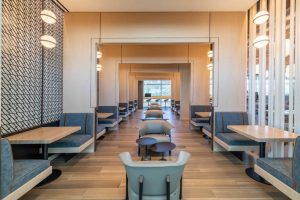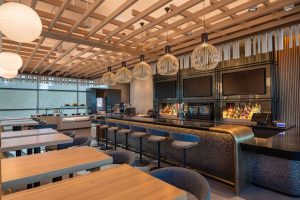Chicago-based architectural firm DMAC Architecture & Interiors modeled the American Airlines (AA) Admirals Club lounges at the Ronald Reagan Washington National Airport (DCA) on the concept of “pavilions in the park,” creating spaces for relaxing and recharging.
Branded elements visually define the two primary spaces in the lounge, which are approximately 1350 m2 (14,500 sf).
- The lounge pavilion is surrounded by tall wood slats, creating an inner sanctuary centered around a fireplace.
- The dining pavilion is surrounded by white tubes which create a light-filled canopied space with multiple seating configurations and expansive views.

The in-between spaces are designed for shorter pausing and regrouping dwell times.
Throughout, the club references local landscapes, landmarks, and building connections to Washington, D.C. Some of the custom features which help establish a sense of place include:
- Two infinity landscapes of cherry blossoms, inspired by spring season in the city, located near the bathrooms.
- Strands of custom hand-crafted pink blossoms hung in a sequence translated from The Star-Spangled Banner.
- A carpet pattern inspired by the landscape of an abstract map of Washington, D.C.

Sustainability is woven into the new design, using conventional and nonconventional practices. Renewable woods add warmth and softness, while finish materials such as stone and metal are detailed to “protect the corners” for long lasting durability. High-efficiency, energy saving LED lighting and window shades adjust to light levels during the day with control systems tuned to the astronomical clock.
Dwayne MacEwen, founder, and principal of DMAC Architecture & Interiors says, “Just as parks are the repose to cities, The Admirals Club is the repose to the airport. The Club is conceived as a collection of thoughtfully designed spaces for guests to relax and recharge, and where many details (large and small) are embedded with local narratives for a sense of place. Every place has a history and a story to tell, and we often tell those stories through design.”





Responses